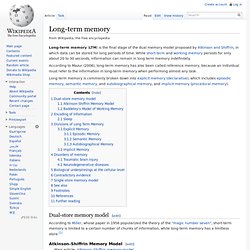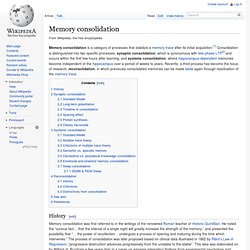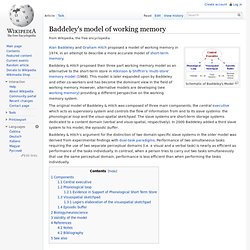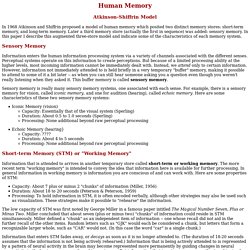

Serial Position Effect Defined - Psychology Glossary. Long-term memory. Long-term memory (LTM) is the final stage of the dual memory model proposed by Atkinson and Shiffrin, in which data can be stored for long periods of time.

While short-term and working memory persists for only about 20 to 30 seconds, information can remain in long term memory indefinitely. According to Mazur (2006), long-term memory has also been called reference memory, because an individual must refer to the information in long-term memory when performing almost any task. Memory consolidation.
Memory consolidation is a category of processes that stabilize a memory trace after its initial acquisition.[1] Consolidation is distinguished into two specific processes, synaptic consolidation, which is synonymous with late-phase LTP[2] and occurs within the first few hours after learning, and systems consolidation, where hippocampus-dependent memories become independent of the hippocampus over a period of weeks to years.

Recently, a third process has become the focus of research, reconsolidation, in which previously-consolidated memories can be made labile again through reactivation of the memory trace. History[edit] Memory consolidation was first referred to in the writings of the renowned Roman teacher of rhetoric Quintillian. Henry Molaison, formerly known as patient H.M., in 1953 before his surgery Lateral view of the hippocampus which is located in the medial temporal lobe.
Baddeley's model of working memory. Schematic of Baddeley's Model Alan Baddeley and Graham Hitch proposed a model of working memory in 1974, in an attempt to describe a more accurate model of short-term memory.

Baddeley & Hitch proposed their three part working memory model as an alternative to the short-term store in Atkinson & Shiffrin's 'multi-store' memory model (1968). This model is later expanded upon by Baddeley and other co-workers and has become the dominant view in the field of working memory. However, alternative models are developing (see working memory) providing a different perspective on the working memory system. The original model of Baddeley & Hitch was composed of three main components; the central executive which acts as supervisory system and controls the flow of information from and to its slave systems: the phonological loop and the visuo-spatial sketchpad.
Components[edit] Baddeley's first model of working memory (without the episodic buffer) Central executive[edit] Phonological loop[edit] Notes[edit] Human Memory: Atkinson-Shiffrin Model. Atkinson-Shiffrin Model In 1968 Atkinson and Shiffrin proposed a model of human memory which posited two distinct memory stores: short-term memory, and long-term memory.

Later a third memory store (actually the first in sequence) was added: sensory memory. In this paper I describe this augmented three-store model and indicate some of the characteristics of each memory system. Sensory Memory Information enters the human information processing system via a variety of channels associated with the different senses. Sensory memory is really many sensory memory systems, one associated with each sense. Iconic Memory (vision) Capacity: Essentially that of the visual system (Sperling) Duration: About 0.5 to 1.0 seconds (Sperling) Processing: None additional beyond raw perceptual processing Echoic Memory (hearing} Capacity: ????
Visual long-term memory has a massive storage capacity for object details. Author Affiliations Edited by Dale Purves, Duke University Medical Center, Durham, NC, and approved August 1, 2008 (received for review April 8, 2008) Abstract One of the major lessons of memory research has been that human memory is fallible, imprecise, and subject to interference.

Thus, although observers can remember thousands of images, it is widely assumed that these memories lack detail. Contrary to this assumption, here we show that long-term memory is capable of storing a massive number of objects with details from the image. We have all had the experience of watching a movie trailer and having the overwhelming feeling that we can see much more than we could possibly report later. Whereas long-term memory is generally believed to lack detail, it is well established that long-term memory can store a massive number of items. There are reasons for thinking that the memories for each item in these large-scale experiments might have consisted of only the gist or category of the image.